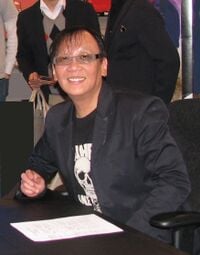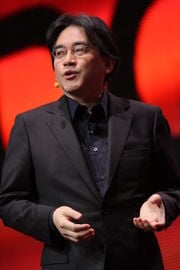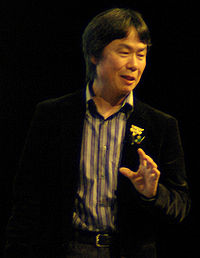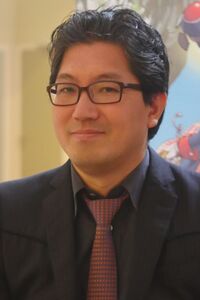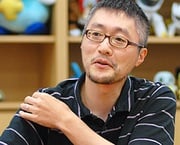List of developers significant to Super Smash Bros.
The following list describes developers that have had a major impact on the development of Super Smash Bros. or one of its major franchises.
Toby Fox
Robert F. Fox, born October 11, 1991, and known professionally as Toby Fox, is an American video game developer and video game composer. He is known for developing the role-playing video games Undertale in 2015, and Deltarune in 2018, for which the former garnered acclaim and he received numerous nominations. Additionally, Fox has participated in a few competitions for Super Smash Bros. Melee, with "Radiation" as his tag name.[1]
The success of Undertale, especially in Japan, afforded Fox the opportunity to visit Masahiro Sakurai at his home, where they discussed the series and played Super Smash Bros. Ultimate against each other. It is also explained during the Mr. Sakurai Presents "Banjo & Kazooie" video. Sans, a character from Undertale, was later included in Ultimate as a Mii costume available through downloadable content, along with his instrumental composition "MEGALOVANIA", for which Fox provided a new arrangement.
Yuji Horii
Yuji Horii (堀井 雄二), born January 6, 1954, is a Japanese video game designer and scenario writer best known as the creator of the Dragon Quest series of role-playing games, supervising and writing the scenario for Chrono Trigger, as well as the first visual novel adventure game Portopia Serial Murder Case. He is also an employee under his own company, Armor Project.
While there were restrictions in the past over having past heroes interact and fight with each other, it has become less strict over time since the release of Dragon Quest Rivals for smartphones. Knowing the popularity of the Super Smash Bros. series, he personally wanted the Hero to join the series, and as such requested Masahiro Sakurai and the team to add the Dragon Quest franchise in Super Smash Bros. Ultimate. Sakurai's initial proposal had only included the Heroes of Dragon Quest III, and Dragon Quest XI; XI's being the default due to being the latest installment and to promote its then upcoming Nintendo Switch port, and III's due to being the most iconic Hero of the series. But Horii allowed more to be included. As a result, and due to time constraint, the Heroes of Dragon Quest IV, and Dragon Quest VIII were added in the game along with the two prior Heroes.[2] Template:Art-dragonquestwiki
Shigesato Itoi
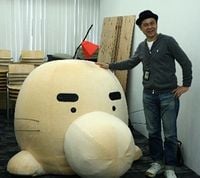
Shigesato Itoi (糸井 重里), born November 10, 1948, is a Japanese copywriter and essayist, best known as the creator of the EarthBound series. He is now the editor-in-chief of his website and company Hobo Nikkan Itoi Shinbun, in short Hobonichi.
Itoi co-owns the rights to EarthBound characters, and as such he is the only individual credited by name on the title screen of every Smash game. He was also part of the original development team for Super Smash Bros. and Super Smash Bros. Melee under HAL Laboratory.
Satoru Iwata
Satoru Iwata (岩田 聡), born December 6, 1959, was a programmer and the fourth President and CEO of Nintendo from 2002-2015. Iwata joined HAL Laboratory in 1980 while attending the Tokyo Institute of Technology, working on titles such as EarthBound and the Kirby series during his time there.
Iwata worked on Super Smash Bros. and Super Smash Bros. Melee closely with Masahiro Sakurai, contributing greatly to the game's debugging process. At E3 2005, Iwata offhandedly announced Super Smash Bros. Brawl while the game had not even been planned. He approached Sakurai the next day and asked him to direct the game.
Satoru Iwata passed away due to medical complications on July 11, 2015.
Hideo Kojima
Hideo Kojima (小島 秀夫), born August 24, 1963, is a video game designer formerly employed by Konami, and the creator of the Metal Gear series. His involvement was instrumental in bringing Solid Snake to Super Smash Bros. Brawl, along with participating in the game's development.
Initially interested in entering the film industry, he would use video games as a stepping stone to get noticed as a writer. He frequently lied about his confession because most people would look down on him for being in the video game industry. Also, there was no formal phrase for "game developer" in the Japanese language at the time, so it was easier to say he was part of a financial firm. To make this façade seem more credible, he decided to join a company on the public stock exchange, and the only publicly traded video game company at the time was Konami, so he applied there. He ended up joining the company in 1986 with the MSX and personal computer division. Kojima really wanted to be in the home console division, as he believed the hardware of the MSX was too restrictive. Nevertheless, he ended up being assistant director for Penguin Adventure before taking over a title called Metal Gear as creative director. Due to hardware limitations making combat difficult to implement, the direction was changed to be more focused on stealth.
Metal Gear became a critical and financial success. While Kojima only planned for that one game, an NES port and sequel to that port were made without his involvement. He notoriously criticized those games and returned with a canonical sequel to right the series back on track. Metal Gear eventually became a long-running franchise and Kojima's main claim to fame. Other projects he was involved in include the film-noir inspired graphic adventure game Snatcher and the science fiction graphic adventure game Policenauts, as well as producing the Zone of the Enders and Boktai series and Castlevania: Lords of Shadow. Kojima would also found a subsidiary within Konami called Kojima Productions, which existed to develop the Metal Gear franchise and other miscellaneous projects; notably P.T., directed with Guillermo del Toro. The latter would be cancelled after Kojima left Konami in 2015. Kojima and his company would continue to work on new games after the departure. One such was Death Stranding, released in 2019, and with the help of Sony Interactive Entertainment. The game would receive a director's cut later in 2021.
According to Masahiro Sakurai, Kojima "practically begged" him to include Snake in Super Smash Bros. Melee, but at that point the game was too far in development to allow adding any additional characters.
When work on Super Smash Bros. Brawl began several years later, Sakurai contacted Kojima about adding Snake, which led to his inclusion in the game. Kojima developed Snake's stage, Shadow Moses Island. After losing a test match of Brawl against Sakurai, where he played as Snake and Sakurai played as Mario, he stated that he felt the game was "very complete" to the point that Nintendo could have put Brawl out on the shelves then and it would sell millions of copies. When asked about the inclusion of Snake in Brawl, Kojima remarked that he enjoys playing Super Smash Bros. with his son, who asked Kojima to put Snake in Brawl. Kojima also cited the lack of Metal Gear games on Nintendo consoles as a reason to include Snake in Brawl.
During an interview with Geoff Keighley for Twitch on March 2014, Kojima was asked about the possibility of Snake reappearing in Super Smash Bros. 4, to which Kojima replied that he had no input on the game and felt Snake's return was unlikely, although he was supportive of Snake returning. Upon the release of Super Smash Bros. 4, it was confirmed that Snake does not make an appearance in the game, and indeed all elements of the Metal Gear universe from Brawl do not return. In late 2015, Kojima left Konami amidst rumors of disagreements with the company's management, and in December of that year reestablished himself as the head of the now independent Kojima Productions studio.
In June 2018, with the formal announcement of Super Smash Bros. Ultimate, it was revealed that Snake would again appear in the Smash roster. His series symbol, formerly the logo of Metal Gear's FOX Unit, was changed to an exclamation point, likely because the FOX logo was also the logo of Kojima Productions while Kojima worked for Konami. Kojima has not publicly commented on Snake's return in Ultimate. Additionally, content from his company other than Metal Gear were featured in Ultimate, like Gabriel Belmont from Castlevania: Lords of Shadow appearing as a spirit after Simon, Richter, and the Castlevania franchise were added.
Shigeru Miyamoto
Shigeru Miyamoto (宮本 茂), born November 16, 1952, is a Japanese video game director, video game producer, concept artist, video game designer, and EAD general manager who is the creator of many Nintendo flagship franchise characters such as Mario, Donkey Kong, Link, Fox McCloud, Olimar, Bowser, Ganondorf, Wolf O' Donnell, Andross, Luigi, Falco Lombardi, Princess Peach, Princess Zelda, Pikmin, and other Nintendo icons. He is known by many as the father of modern gaming, and is often credited with the Nintendo DS and the Nintendo Wii.
Miyamoto is one of the most internationally recognized and celebrated figures in the video game industry. He was even chosen by Time Magazine as one of the 100 most influential people of the year and in 1998, he was the first person to be inducted into the Academy of Interactive Arts and Sciences' Hall of Fame.
Shigeru Miyamoto has worked alongside Masahiro Sakurai throughout the Super Smash Bros. series.
Yuji Naka
Yuji Naka (中 裕司), born September 17, 1965, is a Japanese video game programmer, designer, and producer. He is the former head of the Sega studio Sonic Team, where he was the lead programmer of the original Sonic the Hedgehog series on the Sega Mega Drive, or Sega Genesis in PAL region.
Naka also led development on games other than the Sonic franchise, including Nights into Dreams, Burning Rangers, and contributed to the Phantasy Star franchise. In 2006, he left Sega to found Prope, an independent game company that published games like Shot2048 in 2021. Naka also worked under Square Enix to direct Balan Wonderworld, only to leave the company before the game's release due to issues with both this company, and Arzest.[3]
Like Hideo Kojima with the Metal Gear series, Naka requested Masahiro Sakurai to include Sonic in Super Smash Bros. Melee, but at that point the game was too far in development to allow adding any additional characters.
When work on Super Smash Bros. Brawl began several years later, Sakurai and the team have managed to add Sonic, along with the franchise, in the titular game. Since then, the franchise remained in the Super Smash Bros. series as of 2018's Super Smash Bros. Ultimate.
Additionally, content from his company were featured in the series, with Iris Archwell and the Demon King Arzodius from Monster Manor in Smash for 3DS, and spirits in Ultimate, along with Coraline from Ultimate Angler, Shinobu from Ninja Launcher, and Crispin from Feed Mii.
Tetsuya Nomura
Tetsuya Nomura (野村哲也), born October 8, 1970, is a Japanese video game artist, designer, and director working for Square Enix, formerly SquareSoft. He designed characters for the Final Fantasy series, debuting with Final Fantasy VI and continuing with various later installments. Additionally, Nomura has led the development of the Kingdom Hearts series since its inception in 2002 and was the director of the 2005 film Final Fantasy VII: Advent Children.
Nomura participated in the inclusion of Cloud in Super Smash Bros. 4's DLC with his moveset and character design. The latter was inspired of Cloud's appearance in Dissidia Final Fantasy[4]. He has later illustrated Cloud's challenger illustration for Smash 4.
Nomura has contributed in Super Smash Bros. Ultimate's countdown, as he posted an illustration on the seventh day before its release. Furthermore, many characters from his works were featured in Ultimate. This includes Sephiroth as a playable character along with many characters from Final Fantasy VII as spirits in December 2020, Jin and Malos from Xenoblade Chronicles 2 appearing as spirits in March 2021, and Sora as a playable character along with characters from the Kingdom Hearts series as spirits in October 2021.
Masahiro Sakurai
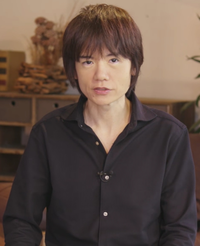
Masahiro Sakurai (桜井 政博), born August 3, 1970, is a Japanese game developer, creator, writer, and voice actor. His most notable creations include the Kirby and Super Smash Bros. series, both of which he created and developed during his tenure with HAL Laboratory. He has since continued his work as director of the Super Smash Bros. series through his company Sora Ltd.
Sakurai first devised the concept for Super Smash Bros. in 1998, working on a prototype then known as Dragon King: The Fighting Game. At the time, the project featured no existing Nintendo properties, and Sakurai was focused on creating unique platform fighter mechanics to differentiate the title from traditional fighting games. However, Sakurai decided that the inclusion of Nintendo characters would give the game more atmosphere. The final product, Super Smash Bros., was released in January 1999 and became an unexpected hit. The success of this title would give an opportunity to create a new series, with sequels made for it. Sakurai has also provided the voice for King Dedede in Kirby 64: The Crystal Shards, and would reprise the role in Super Smash Bros. since the character's debut in Super Smash Bros. Brawl.
In addition to his work in developing and presenting the games, Sakurai wrote and maintained Sumabura-Ken, a website which in its various incarnations detailed the content and gameplay of Smash 64, Melee, and Brawl. The localized version of the Brawl website was known in English as the Smash Bros. DOJO!! Though a separate official website was created for Smash 4, Sakurai posted daily updates about the games' development to the Director's Room Miiverse community throughout 2013 and 2014. The official website for Ultimate also features daily updates from Sakurai, which are also available through a Nintendo Switch News Channel.
Ken Sugimori
Ken Sugimori (杉森 建), born January 27, 1966, is a graphic artist from Japan who is the art director of the Pokémon games. Sugimori designed the first 151 Pokémon virtually by himself, and since Pokémon Ruby and Sapphire Version, he has been part of a character design team. His other work for the series includes the design for the human characters such as Gym Leaders, as well as the 1st and 2nd Generation of Pokémon trading cards. Sugimori's art pieces of each Pokémon are commonly used for generic images of each character on forums and websites. Sugimori is a close friend of Satoshi Tajiri, the creator of Pokémon, and co-founded Game Freak with him.
Sugimori has helped on the art direction for the Pokémon of the Super Smash Bros. series. Sugimori has also illustrated Greninja's challenger illustration for Super Smash Bros. 4.
References
- ^ A set of Toby Fox playing melee. His tag is Radiation.. Reddit (September 5, 2019).
- ^ Alistair Wong (September 26, 2019). Masahiro Sakurai And Yuji Horii Discuss Smash Ultimate’s Hero DLC, Director Philosophy, And More. SiliconEra.
- ^ Parrish, Ash; Sato, Mia. Yuji Naka says Square Enix doesn’t ‘value games’ after Balan Wonderworld mess. Retrieved on May 3, 2022.
- ^ Soma (January 20, 2016). Sakurai x Nomura: Creator Interview 2016 [Part One]. Retrieved on April 18, 2022.


